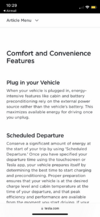Is it me, or is it crazy that Tesla takes uses the battery to heat the car when plugged in to a 240v circuit? That's just unnecessary use/abuse of the precious battery that we all go to such lengths to preserve! So when I'm warming up the cabin on these 15 degree mornings in the winter, defrosting all the snow and ice off my car, I'm just sucking energy from the battery, almost no different than driving? That's not an insignificant amount of use, if this is really how it works. And it seems completely unnecessary. Am I wrong here?



